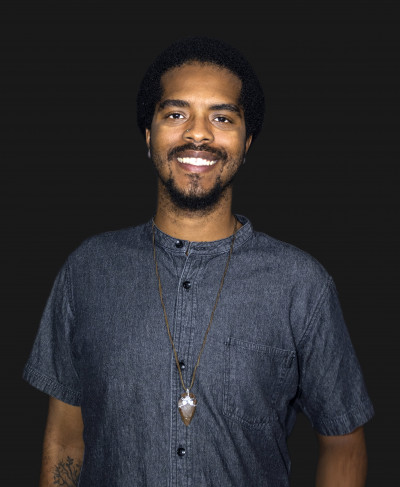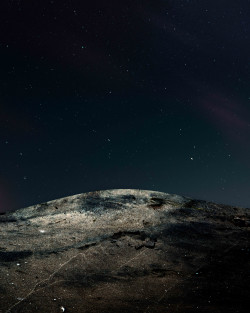
Today, Granville is a visual artist and recent Masters of Fine Art graduate from the Rochester Institute of Technology. Granville’s work is focused on Afrofuturism, a process through which the Black identity is reimagined through technology, the imagination, and science fiction. Landscapes are deconstructed and digitally rebuilt, and portraits are broken down to silhouettes and filled with extraterrestrial details. He also addresses issues of Black representation within photography.
When Granville enrolled at MCC, his coworker’s encouragement to pursue photography stuck. He took Photography 1 with professor Ron Bimrose and Photography 2 with professor Joe Travino. During those first photography classes, Granville learned how photography could be used as an artistic tool.
“At first I set out to be a purist, but photo editing made me want to see the world in different ways,” Granville said.
In an Introduction to Digital Arts class with professor Rosie Shipley, he learned about multiple image layering through Photoshop, which laid the foundation for his current aesthetic of reconstructed landscapes and portraits with starry layers.
As his passion for photography and art grew, Granville decided to switch the focus of his studies from psychology to the arts.
When he graduated from MCC with an Associate in Arts in 2015, Granville transferred to Arizona State University’s (ASU) Herberger Institute for Design and the Arts, where he earned a Bachelor of Fine Arts. Granville says that the portfolio of work he built at MCC helped him in his application to ASU.
One of his ASU professors, Stephen Marc, encouraged him to study art for a Masters degree, which led him to the Rochester Institute of Technology.
While in grad school in Rochester, Granville’s work began to take on a darker, more somber tonal range, focusing on the literal and metaphorical aspects of blackness. In Arizona, his work featured more light due to the ever-present desert sun. He also began to give student teaching a try, considering it as a possible pathway to sharing his passion for photography with others. As Above, So Below by Granville Carroll
As Above, So Below by Granville Carroll
In May of 2020, Granville graduated from the Rochester Institute of Technology with a Masters of Fine Art in photography and related media.
“The biggest thing that set me on this path was connecting with my professors at all the institutions I’ve been at, and embracing the unknown,” he said. “When I decided to become an artist and follow this path, I didn’t know where it would take me. I never intended to get a Master’s in Photography or even a Bachelor’s.”
In Fall of 2020, Granville began teaching Digital Photo classes at Arizona State University as a Faculty Associate. When he joined his first faculty meeting (a virtual meeting because of the pandemic), Granville noticed a familiar face.
“My MCC Intro to Digital Arts professor Rosie Shipley was on the call. I had no idea she started teaching at ASU!” Granville said.
When asked about his future career aspirations in addition to teaching, Granville replied that he’d possibly like to work in an art gallery at some point to connect with other artists and art professionals and explore artist residencies.
 Ori, 2019, From Because the Sun Hath Looked Upon Me by Granville Carroll
Ori, 2019, From Because the Sun Hath Looked Upon Me by Granville Carroll
Granville stressed the importance of experimenting and not fearing momentary failure as a part of his journey.
“Take those moments as learning opportunities and ways to grow,” he said.” Draw inspiration from everything you encounter such as music, film, books, etc. These things will help feed your creative mind.”
His advice to aspiring artists and photographers?
“Trust yourself. Be open to criticism, be open to being vulnerable. Vulnerability is such an important part of being an artist because it gives people access to you. If you remain closed, it doesn’t give you space to think creatively and allow people to recognize what you’re attempting to do.”

